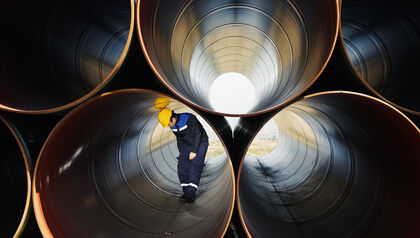How A&E Firms Can Claim the Section 179D Energy Efficient Deduction
The Inflation Reduction Act of 2022 (IRA) was signed into law on August 16, 2022 and has substantially increased the benefits of the Section 179D Energy-Efficient Commercial Building Deduction.
This landmark legislation includes a $369 billion investment in green energy projects, nearly tripling the Section 179D deduction for qualified buildings. Additionally, the Inflation Reduction Act expanded the types of buildings eligible under Section 179D. Paired with its recently enacted permanence, the updated 179D program has ensured that more taxpayers than ever will be eligible to take advantage of it.
Inflation Reduction Act: 179D Deduction Key Changes
For buildings placed into service after 2022, taxpayers will be able to claim a deduction of up to $5 per square foot for eligible properties. To qualify for this increased deduction amount, companies must meet new prevailing wage, paid during construction and apprentice program requirements.
The threshold to qualify as an energy-efficient building has also decreased. For a building to yield a deduction, a reduction in annual energy costs of 25% must be calculated, down from 50%. The deduction will then be calculated on a sliding scale from 25-50%, with $5 per square foot being available at a calculation of 50% reduction in energy costs per year.
This new method of calculation means that every percentage point of cost reduction will have an impact on the deduction available for a given building. Partnering with a team of experts that can model your projects accurately and thoroughly is more impactful than ever.
For those projects that do not meet the prevailing wage requirements or do not reach a calculated 50% savings, partial deductions are available. A new alternative calculation method may now be used to claim any remaining deductions for a building that does not reach the $5 per square foot maximum outright. To reduce energy consumption, a taxpayer who is certified by a qualified architect or engineer may now claim a deduction based on an annual reduction of energy intensity by comparing the actual energy used before and after a qualified retrofit of an eligible building.
For projects set to be complete in 2023, the Section 179D deduction for a qualified building will be reset every four years, or three years for certain buildings. This means that if an additional energy upgrade is performed on a building after the initial project, an additional $5 per square foot may be claimed, provided at least a four-year period has passed since the last project was completed.
For those buildings that are placed into service before these changes take effect, an inflation-adjusted deduction of up to $1.88 per square foot may be claimed for an eligible commercial property.
What Is an Eligible Commercial Building Under Section 179D?
With the Inflation Reduction Act, the Section 179D deduction is now available for any qualifying commercial building, particularly tax-exempt, energy-efficient buildings. These buildings can include schools, hospitals, churches, charitable organizations and facilities owned by any level of government.
Because the owners of these public and non-profit buildings are nontaxable entities, the deduction can then be passed on to the primary designers of the properties—these parties can include engineers, architects, contractors, energy services providers and environmental consultants. The purpose of the deduction is to incentivize designers of tax-exempt buildings to utilize energy efficient systems and components within the construction projects.
These types of eligible buildings are in addition to privately-owned commercial buildings for which the 179D deduction was originally intended.
What Steps Must be Taken To Claim a 179D Deduction?
In a Section 179D study, a qualified third party—separate from the designer taking the Section 179D deduction—uses IRS-approved energy software to model the energy performance of the building and improvements.
The qualified third party must be a professional engineer (PE) licensed in the state where the building is located. The third party must review the results of the energy model and verify that the improvements meet the applicable energy-savings thresholds using the American Society of Heating, Refrigerating and Air-Conditioning Engineers (ASHRAE) standards.
The qualified third-party must also sign a certification document for the Section 179D deduction stating they have examined the energy model and support the allocation of the deduction to its respective designer.
For those taxpayers that wish to claim a Section 179D deduction for a tax-exempt building, a statement must be signed by the designer and the building owner allocating the deduction to the qualified taxpayer. Cherry Bekaert will work with you to create the allocation statement and secure the needed signatures.
The deduction can now be up to $5 per square foot for 2023 projects. To qualify for the maximum deduction amount, certain prevailing wage and apprenticeship requirements must be met and documented for the construction project. If neither of these requirements are met, a maximum deduction is available of $1 per square foot.
Cherry Bekaert is Here to Help You Benefit from the Section 179D Changes Included in the Inflation Reduction Act of 2022
If you have any questions regarding the Section 179D and the expansion of the deduction included in the Inflation Reduction Act of 2022, Cherry Bekaert’s Tax Credits & Incentives Advisory and Professional Services Industry teams are available to discuss your situation with you.
Cherry Bekaert’s Professional Services Industry team is comprised of accounting and tax advisors and business strategists, technologists and analysts who have extensive A&E firm industry experience and keen business acumen. Our team of advisors continues to share innovative ideas, industry trends, regulatory compliance and best practices to guide A&E firms forward. Watch for future podcasts, webinars and articles in the coming months specifically tailored to the unique tax, financial and business needs of A&E firms, to keep you informed on proven solutions that can have a positive financial and operational impact on your business.
Related Guidance
- How Can A&E Firms Take Advantage of New Tax Credits in the Inflation Reduction Act?
- Global A&E Firm Saves $2 Million with 179D Tax Deduction
- Inflation Reduction Act of 2022: Key Income Tax Provisions
- Inflation Reduction Act Tax of 2022: Details & Tax Changes
- Inflation Reduction Act Doubles R&D Tax Credit to Offset Payroll Taxes for Start-Up Businesses





